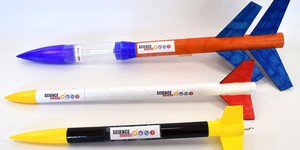Eighth Grade, Space Exploration Science Projects (24 results)
Space exploration is an exciting and wide-ranging area. Getting into space (and back down) is hard, involving rockets and launch vehicles, satellites, spacecraft, re-entry systems, landers and rovers, robots, and orbital mechanics, not to mention hypothetical technologies like space elevators and artificial gravity. To survive and thrive in space, we must understand many additional issues such as human performance in space, the space economy, and the science of astronomical bodies.
|
Select a resource
Coding Projects
Sort by
|
Can humans grow food in space? Can we grow plants on the Moon or on a space station? This is an important question to answer as humans look to expand our existence to the Moon, Mars, and beyond. In this science project you will build a clinostat, a device that can simulate microgravity right here on Earth and use it to explore the effects of microgravity on plant growth.
Read more
Imagine that you need to make sure valuable cargo — like a robot or even human astronauts — can land safely on Mars. How would you do it? In this project, you will build your own model planetary lander using an Arduino. It will use a distance sensor and automatically deploy landing gear before impact. Can you avoid a crash landing?
Read more
New
Have you ever seen a waiter balance an entire tray of drinks without spilling any? How do they do it? Do you think you could build a robot waiter that can do the same thing? In this project, you will learn how to build a self-balancing robotic tray. You can incorporate the auto-leveling tray into one of our many other robotics projects, like the Bluebot or robotic arm.
Read more
Rockets are definitively an engineering challenge. These amazing gravity-defying machines have lifted test material, people, and even animals into space. Feel like building one yourself? In this science project, you will transform a water bottle into an aerodynamic bottle rocket with two compartments, one for the fuel and one for a payload. You will then test how well it performs when lifting mass vertically up into the air. Ready, set, soar!
Read more
Why do the planets orbit the sun without flying off into space? Do they move in perfect circles or do their orbits take a different shape? And how could you possibly do a science project about any of this—you can't do an experiment with the planets! However, you can build a model of our solar system that demonstrates the concept of gravity, using balls of different sizes to represent the sun and planets. Watch the summary video for an excellent introduction to the model.
Think about how…
Read more
What keeps a model rocket on course? How can you make sure a model rocket design is stable before you launch it? Find out in this project as you learn about center of mass, center of pressure, and their effect on a rocket's stability.
Read more
New
How do you feel right now? Do you remember how you felt a few hours ago? How about yesterday or last Wednesday? What if you could track your emotions throughout the day and use this information to help improve your mood and well-being? In this science project, you will program a simple, pocket-sized device that you can carry around with you to log your feelings whenever you want or on a specific schedule.
Read more
Companies like SpaceX and Blue Origin are dramatically lowering the cost of space flight by designing reusable rocket boosters that land back on Earth. Getting a rocket to land vertically without any damage - and without using a parachute to slow it down - is quite a tricky physics problem! In this project you will modify your own model rocket so it can land vertically.
Read more
What does it take to launch a robot to Mars or for a satellite to explore our outer solar system? In this project you will explore the physics of a rocket as you predict its performance, launch it, and measure the actual results. This is rocket science!
Read more
You've heard of gold mining and coal mining, but think outside the box...or the planet...what about asteroid mining? Scientists, engineers, and business people believe asteroid mining is feasible, and they are in the beginning stages of long-term plans to mine asteroids for valuable resources during space missions. You don't want to miss out on all the fun; in this science project, you will come up with your own scientific plan for an asteroid mining company. We will help get you started by…
Read more
You might not think a chip of paint could cause a lot of damage, but what if it is traveling 18,000 miles per hour? That is the reality astronauts face on the International Space Station (ISS). Learn how engineers protect the ISS from space debris in this fun science project as you build your own model spacecraft shield and conduct your own impact tests!
Read more
The movement of satellites is intriguing, but how do they orbit the way they do? Aerospace engineers run calculations and set up computer models to help them predict how satellites move in space, but in this astronomy science project, you will create a physical model with marbles, clay, and a cookie sheet to help you study how satellites move in space and learn from your observations.
Read more
|


















